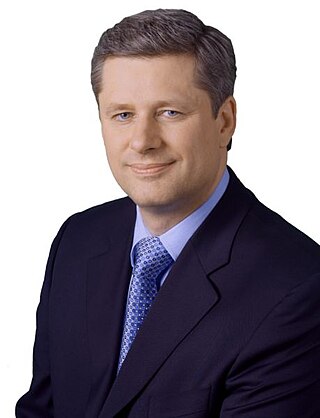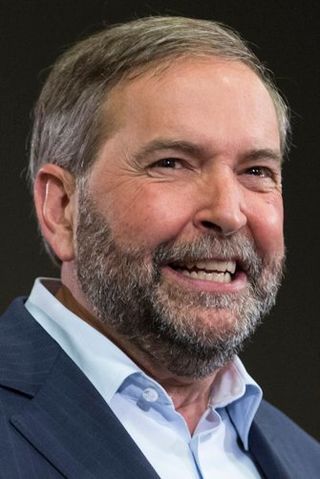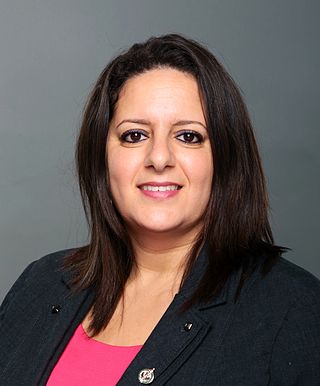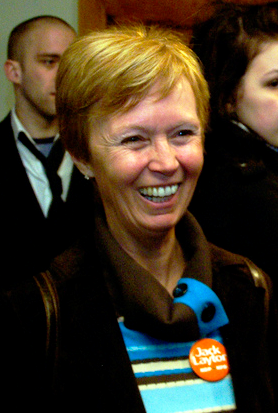Related Research Articles

John Gilbert Layton was a Canadian academic and politician who served as the leader of the New Democratic Party (NDP) from 2003 to 2011 and leader of the Official Opposition in 2011. He previously sat on Toronto City Council, occasionally holding the title of acting mayor or deputy mayor of Toronto during his tenure as city councillor. Layton was the member of Parliament (MP) for Toronto—Danforth from 2004 until his death.

The 2004 Canadian federal election was held on June 28, 2004, to elect members to the House of Commons of Canada of the 38th Parliament of Canada. The Liberal government of Prime Minister Paul Martin lost its majority but was able to continue in office as a minority government after the election. This was the first election contested by the newly amalgamated Conservative Party of Canada, after it was formed by the two right-of-centre parties, the Progressive Conservative Party and the Canadian Alliance.

The leader of the Official Opposition, formally known as the leader of His Majesty's Loyal Opposition, is the politician who leads the Official Opposition in Canada, typically the leader of the party possessing the most seats in the House of Commons that is not the governing party or part of the governing coalition.

Françoise Boivin is a Canadian politician, who represented the electoral district of Gatineau in the House of Commons of Canada until 2015.

Peggy A. Nash is a Canadian labour official and politician from Toronto, Ontario, Canada. She was the New Democratic Party (NDP) Member of Parliament (MP) for the Parkdale—High Park electoral district (riding) in Toronto, and was the Official Opposition's Industry Critic. Before becoming a parliamentarian, she worked as a labour official at the Canadian Auto Workers union (CAW).
Upon the dissolution of the 39th Canadian Parliament, 65 of the 308 seats were held by women. Canada ranks 45th in the world in representation of women in the national lower house.

The 40th Canadian Parliament was in session from November 18, 2008 to March 26, 2011. It was the last Parliament of the longest-running minority government in Canadian history that began with the previous Parliament. The membership of its House of Commons was determined by the results of the 2008 federal election held on October 14, 2008. Its first session was then prorogued by the Governor General on December 4, 2008, at the request of Prime Minister Stephen Harper, who was facing a likely no-confidence motion and a coalition agreement between the Liberal party and the New Democratic Party with the support of the Bloc Québécois. Of the 308 MPs elected at the October 14, 2008 general election, 64 were new to Parliament and three sat in Parliaments previous to the 39th: John Duncan, Jack Harris and Roger Pomerleau.
The New Democratic Party is a federal political party in Canada. Widely described as social democratic, the party sits at the centre-left to left-wing of the Canadian political spectrum, with the party generally sitting to the left of the Liberal Party. The party was founded in 1961 by the Co-operative Commonwealth Federation (CCF) and the Canadian Labour Congress (CLC).

The 2011 Canadian federal election was held on May 2, 2011, to elect members to the House of Commons of Canada of the 41st Canadian Parliament.
This article covers the history of the New Democratic Party of Canada.
The 40th Canadian Parliament contained a record number of female Members of Parliament, with 69 women elected to the House of Commons of Canada in the 2008 federal election. However, this represented just 22 per cent of the 308 total MPs, and only a modest gain over the 65 women in the 39th Canadian Parliament.

This article outlines the events leading up to the 41st Canadian federal election of May 2, 2011, starting with the prior election.

The 41st Canadian federal election was held on May 2, 2011. It resulted in a Conservative majority government under the leadership of Prime Minister Stephen Harper. It was the third consecutive election win for Harper, and with 166 of 308 seats, giving them a majority government for the first time in their eight-year history. It was also the first right-of-centre majority government since the Progressive Conservatives won their last majority in 1988. The Conservative Party won 39.62% of the popular vote, an increase of 1.96%, and posted a net gain of 24 seats in the House of Commons.

The Official Opposition Shadow Cabinet in Canada is composed of members of the main Opposition party responsible for holding the Government to account and for developing and disseminating the party's policy positions. Members of the Official Opposition are generally referred to as Opposition Critics, but the term Shadow Minister is also used.

Sana Hassainia is a Tunisian born Canadian politician. She was elected to the House of Commons of Canada in the 2011 election as the New Democratic Member of Parliament for Verchères—Les Patriotes. She left the NDP caucus on August 20, 2014 as the result of a dispute with NDP leader Thomas Mulcair's position on the Israeli–Palestinian conflict and completed her term as an Independent MP.

Nycole Turmel is a Canadian politician who served as the member of Parliament (MP) for Hull—Aylmer from 2011 to 2015. A member of the New Democratic Party (NDP), Turmel served as the party's interim leader from 2011 to 2012.
This is a timeline for the 42nd Canadian federal election, which took place in October 2015.
The 42nd Canadian Parliament includes a record number of female Members of Parliament, with 88 women elected to the 338-member House of Commons of Canada (26%) in the 2015 election. This represents a gain of twelve seats over the previous record of 76 women in the 41st Canadian Parliament. By contrast, the 114th United States Congress had 105 women sitting in the 435-seat United States House of Representatives.
The 43rd Canadian Parliament once again set a record number of female Members of Parliament, with 98 women elected to the 338-member House of Commons of Canada (28.9%) in the 2019 election. Of those 98 women, 31 were elected for the first time in the 2019 election. 2 more women were elected in by-elections in October 2020, reaching the historic milestone of 100 women in the House of Commons for the first time. This represents a gain of twelve seats over the previous record of 88 women in the 42nd Canadian Parliament. By contrast, the 116th United States Congress had 102 women sitting in the 435-seat United States House of Representatives (23.4%).

The 44th Canadian Parliament includes a record number of female Members of Parliament, with 103 women elected to the 338-member House of Commons of Canada (30.5%) in the 2021 election. Of those 103 women, 22 were elected for the first time in the 2021 election. This represents a gain of five seats over the previous record of 98 women elected at the beginning of the 43rd Canadian Parliament, and a gain of three seats from the record high of 100 women during the previous parliamentary session following by-elections.
References
- ↑ "Record number of women elected". CBC News, May 3, 2011.
- ↑ "Parliament gets a makeover: An influx of young women could help change Canadian politics for good". Ottawa Citizen , May 6, 2011.
- ↑ Parliament of Canada: Women Candidates in General Elections